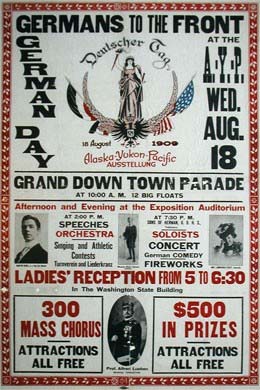On August 18, 1909, German Day ("Deutscher Tag") is celebrated at the Alaska-Yukon-Pacific Exposition on the grounds of the University of Washington in Seattle. The exposition took place between June 1 and October 16, 1909, drawing more than three million people. Visitors came from around the state, the nation, and the world to view hundreds of educational exhibits, stroll the lushly manicured grounds, and be entertained on the Pay Streak midway, while Seattle promoted itself as a gateway to the rich resources of Alaska, the Yukon, and Asia. Each day (except Sunday) of the A-Y-P was designated as a Special Day for one or more groups. Special Days drew people involved in the featured organizations, and the resulting programs, lectures, ceremonies, parades, and athletic competitions gave local people a reason to visit again and again. The German Day celebrations begin at 10 a.m. with a Grand Parade downtown and continue throughout that day and into the evening, presenting fairgoers with a series of entertainments, refreshments, and activities based around traditional German culture and musical performances.
Willkommen To The Expo
The local German community was primed for their day of honor on August 18th, and what the Seattle Daily Times described as “enormous crowds” lined 2nd Avenue downtown to view the spectacle of the largest parade thus far in Seattle history. Led by platoons of policemen, the three-mile-long parade consisted of an estimated 7,000 to 10,000 participants including uniform-clad, horse-riding trumpeters, numerous horse-drawn red-white-and-black flag-draped floats guided by medieval-attired men, several hundred “gaily decorated” cars, various local German singing groups, and, sprinkled throughout, six brass bands.
Following that parade, more than 35,000 people attended the fair that day and at 2 p.m. what was described as the largest crowds yet to fill the Exposition Auditorium heard a song by Theodore H. “Dad” Wagner’s A-Y-P Band and a welcoming speech by Mayor John F. Miller. Miller stated: “There is not a person in Seattle of the vicinity who is unaware that this is German day” (Seattle Post-Intelligencer). Then a Mr. Oswald Lohan of the Imperial German Council dutifully announced that a cablegram of congratulations had just been received from Germany’s Kaiser Wilhelm:
“His majesty the emperor has ordered me to send the German-Americans at the German Day celebration in Seattle his highest greetings, and his majesty hopes that this celebration will also help to maintain the attachment to the old Fatherland without disloyalty to the new. It gives me great pleasure to obey this highest order of the emperor and I for myself send you the best wishes for your festivities” (Translation, Seattle Post-Intelligencer).
Celebration and Song
From there Louie Lepper led the Seattle Turnverein chorus in a song, there were demonstrations of flag and dumbbell exercises, a performance of “The Star Spangled Banner” with an orchestra conducted by Seattle’s pioneering German bandleader, Alfred Lueben, and a final song by the North Pacific Singing organization.
After all that, the action moved over to the stadium where myriad additional activities commenced including various athletic contests (100-yard dash, high jumps, etc.), physical exercises for the public, and the audience was encouraged to sing along with the favorite old German patriotic anthem, “Die Wacht Am Rhein” (“the watch/guard on the Rhine”). Then, from 5 p.m. until 6:30, there was a Ladies Reception in the Washington State Building (with refreshments), and at 7:30 p.m. the evening’s fun began (at the Auditorium):
Among the highlights were: the opening overture by Lueben’s orchestra; a welcoming speech by Miss Hanna Geissler; the singing of the “German and American National Hymn” by the audience (with orchestra); an instrumental solo of a concerto by Wieniawski by “Master Violinist” Robert Velten; a performance of “Waldgesprach” by contralto vocal soloist, Mrs. Lionberger Scott; the presentation of a “cherusker tableaux” by the Sons of Herman (O.D.H.S.); the performance of a “Deutsches Lieder Potpourri” by the orchestra; some German comedy (“The Girl from the Alps and the Beggar Boy”); a one-act sketch (“Di Himmel Ruehmen des Ewigen”) by Lueben’s son-in-law, Martin Dudel (along with two choruses: the Seattle Liederkranz and the Portland Turn-verein); the “Nadesha” aria by Mrs. Lionberger Scott; “To Your Health You Beautiful Maid” as sung by the North Pacific Singing Organization; “Durch Kampf Zum Sieg” (“Through Battle to the Victory”) by the orchestra; and finally the audience reprised “Die Wacht Am Rhein.”
The whole grand celebration was then capped off with a spirited reception and dance at the auditorium from 9 p.m. until 12 p.m. when all attendees presumably finally wound things down by bidding each other a fond “Guten Nacht” and happily making their ways home.

